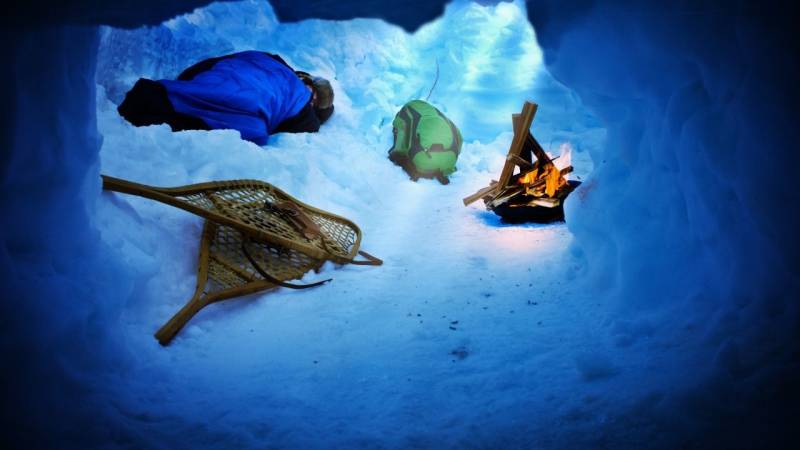
7 dangers of snow caves and how to avoid them (+opinion from a survival trainer)
👉 The key facts from this guide
- Digging a snow cave can lead to hypothermia, as physical exertion can cause sweating and thus loss of body heat.
- The snow cave can collapse if the snow is too wet or the roof is too thin. It is important that the roof is at least 30 cm thick.
- Avalanches can pose a serious threat if the snow cave is built in a vulnerable area.
- Carbon monoxide poisoning can occur if a fire is ignited in the snow cave. Therefore, it is advisable to make the fire outside the snow cave.
- One can get trapped in the snow cave if heavy snowfall blocks the entrance.
- Injuries can occur during the digging of the snow cave, especially if multiple people are digging at the same time.
- Hypothermia can also occur in the snow cave if it is not built correctly and body heat is not adequately insulated.
You surely know that a snow cave is a great shelter against the cold.
They are used by people all over the world and are popular among mountaineers, outdoor enthusiasts, and winter survivors.
But unfortunately, snow caves are also dangerous. Especially for inexperienced and unprepared people, they can become a death trap.
Now you will find the 7 most common dangers of snow caves and how to avoid risks.
To match this, I asked Dominik Knausenberger from lebe-die-wildnis.de for his tips.
A snow cave is not an igloo or Quinzee
So that you know what I'm talking about, I have to clarify a question first:
What is the difference between a snow cave and an igloo or Quinzee?
A snow cave is a hill created by nature, such as a snowdrift.
A snowdrift is a heavily compacted snow deposit at terrain edges in the middle and high mountains.
An igloo or Quinzee is built by you yourself. An igloo is built piece by piece, and a Quinzee is a hill that is then hollowed out.
How big should a snow cave be?
I passed the question on to Dominik. Here is his answer:
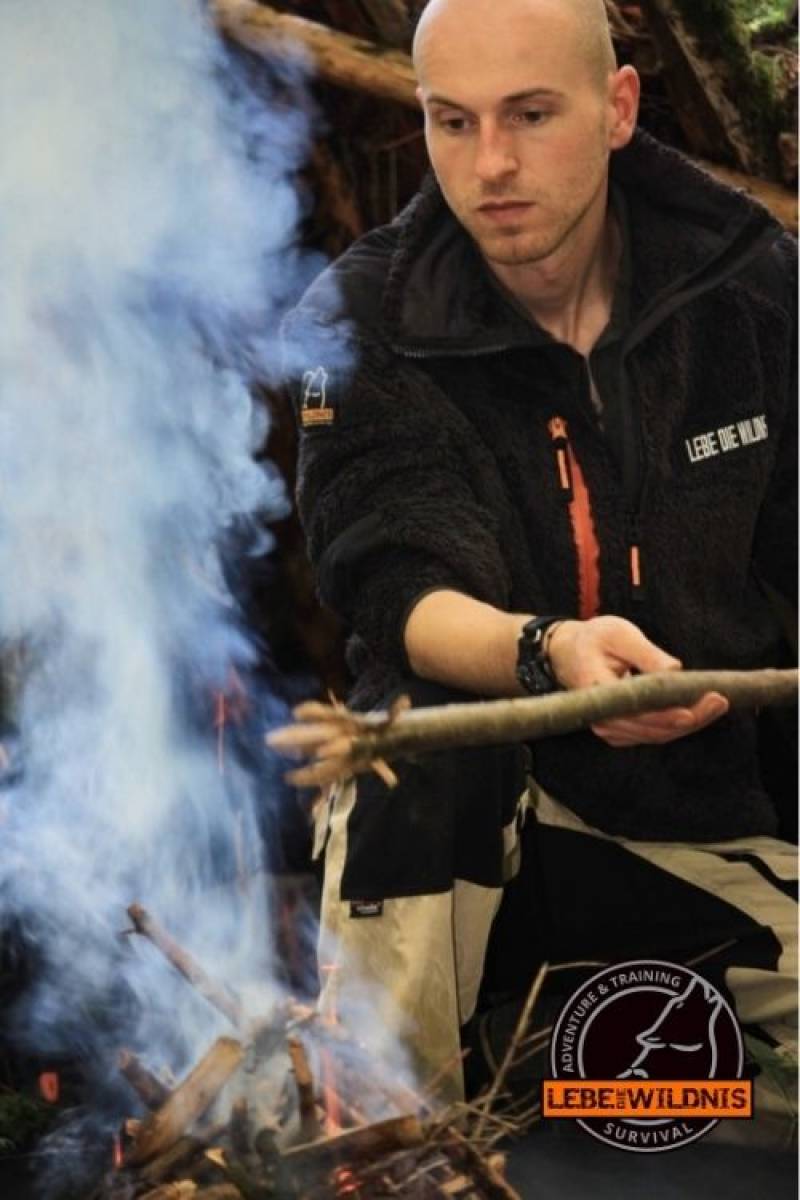
Dominik Knausenberger from lebe-die-wildnis.de
Make the cave a little bigger if possible. The height of the sleeping area up to the ceiling should be at least 0.90 meters and the length at least 2.20 meters. More is better so that you can move more freely and the sleeping bag does not lie directly in the snow.
Dominik Knausenberger
Class, so we have already clarified the basics.
Now let's start with the dangers.
1. Hypothermia caused by digging a snow cave
It is clear that you have to build your snow cave. That alone can lead to problems - let's take a look at them.
When you build your snow cave, you need a lot of energy. You have to move and compact kilos of snow.
As a result, you will start to sweat. And that is an issue.
Sweating can cause you to lose body heat.
And that is fatal. It is incredibly important to stay dry in every situation (especially in winter).
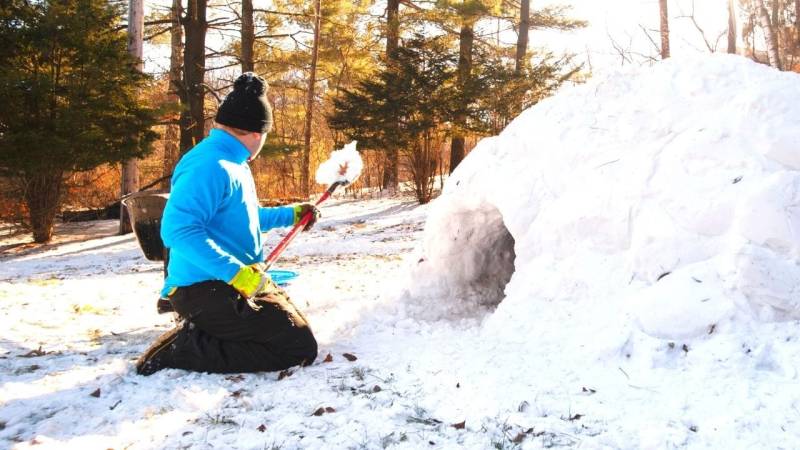
What can you do about it?
Take regular breaks.
Breaks, of course, mean loss of time. Therefore, remember to start building your snow cave early enough.
In addition, take off clothing when you sweat. Only wear the base layer of your clothes.
The less moist it gets, the less you have to dry later.
2. Hypothermia in the snow cave
Your snow cave is built, but it's not getting any warmer?
Then you probably made the mistake that most people make: you built the snow cave wrong.
To be protected from wind and weather, the snow cave must be built correctly.
Your snow cave depends on your body heat. You are literally the heater.
And warm air rises, right?
The correct construction is important. Dig a hole horizontally into a slope and then hollow out a room upwards. The sleeping area should be raised so that the cold air can sink to the ground in a cold trench.
Dominik Knausenberger
So, it is quite possible that you have built the entrance too large or too high. Most of the warm air escapes there.
Make sure that your sleeping area in the snow cave is significantly higher than the entrance.
For additional insulation against the cold from below, the sleeping area can be lined with spruce branches. Of course, this only works if you are below the tree line.
Dominik Knausenberger
Also check out my winter survival tips, where I go into more detail about clothing.
3. Collapses are one of the most common problems with snow caves
Your roof must never collapse.
Imagine if that happens in the middle of the night. All that work for nothing and you are immediately exposed to the cold and wind.
When choosing the camping spot, make sure to avoid areas with possible avalanches, snow slides, or large snowdrifts on mountain ridges.
Dominik Knausenberger
Collapses can occur due to various problems:
The snow is too wet. The problem occurs when it is not cold enough. Snow caves are ideal when there are sub-zero temperatures. If it is warmer, take a tent.
The roof is too thin. Build your snow cave so that the roof is at least 30 cm thick. Snowdrifts and snow hills that are shaped like a dome are ideal. This gives you the best stability. A roof that is too thick is also not good as it is heavy.
Pressure on the roof. Do not build your snow cave against rock walls or under rotten trees. Stones can break off or branches can come crashing down. If you are with several people, mark the roof. This ensures that nobody accidentally walks over it.
4. Avalanches
Avalanches are always a threat in the mountains. I hope you will familiarize yourself with the subject in detail before heading out.
But even the best protection and precautions are no guarantee of safety.
Avalanches occur again and again, completely unexpectedly.
You may be buried in your snow cave, your exit may be blocked, or your air holes may be blocked. The latter leads to suffocation because too much carbon monoxide is produced.
To avoid avalanches, observe the local conditions, check avalanche forecasts, and always be aware of avalanche danger.
5. Carbon monoxide poisoning
I have already mentioned this, and the same applies in normal caves: make sure you have enough oxygen supply.
In small caves - whether normal caves or snow caves - you should not light a fire.
Sure, it's tempting because it makes it warmer and you can cook your food.
However, it's really dangerous.
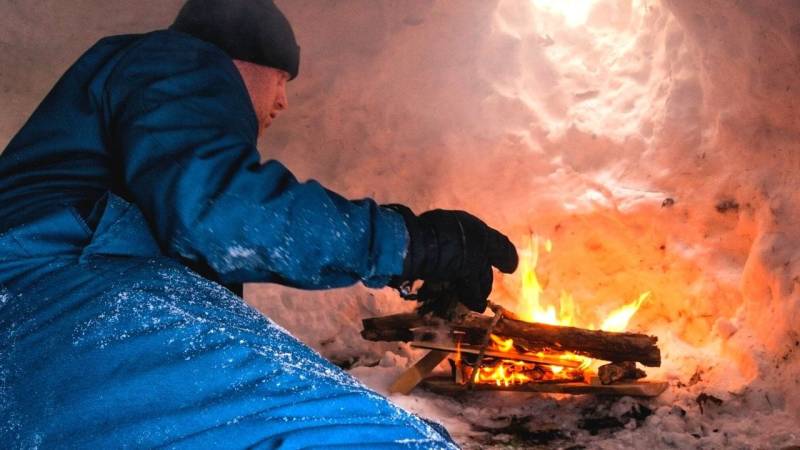
Even petroleum lamps emit carbon monoxide.
You cannot see carbon monoxide (colorless gas) and you cannot smell it either. Symptoms of carbon monoxide poisoning are unspecific and range from dizziness and headaches to unconsciousness and death.
At best, you fall asleep and never wake up again.
So, your fire pit is always outside your snow cave. In addition, build a snow wall on the weather side for more protection.
As an alternative to petroleum lamps, use a candle, which emits much less carbon monoxide.
A candle provides more light and warmth than you might think. It should not be missing when sleeping in a snow cave. The entrance can be closed with large snow blocks. For small caves, however, sufficient ventilation should be ensured by making holes in the outer wall with a ski pole.
Dominik Knausenberger
6. Trapped in the snow cave
Naturally, you also want to get out of the snow cave again. But that's not always easy.
I already mentioned the avalanche, but there is more that can block your way.
Heavy snowfall during the night can easily block your entrance. Then you have to start digging.
You can clear the snow more easily if your entrance is downhill and on the windward side. This also makes it easier to build the snow cave, and not so much snow blows into the entrance.
A snow cave is preferably dug into the lee side of hills and safe snow drifts. The snow there is usually sufficiently compacted and deep enough. It's worth using a ski pole to check the depth of the snow!
Dominik Knausenberger
But more importantly, take your shovel (or other digging tool) with you into your cave.
Therefore: Never leave your equipment outside.
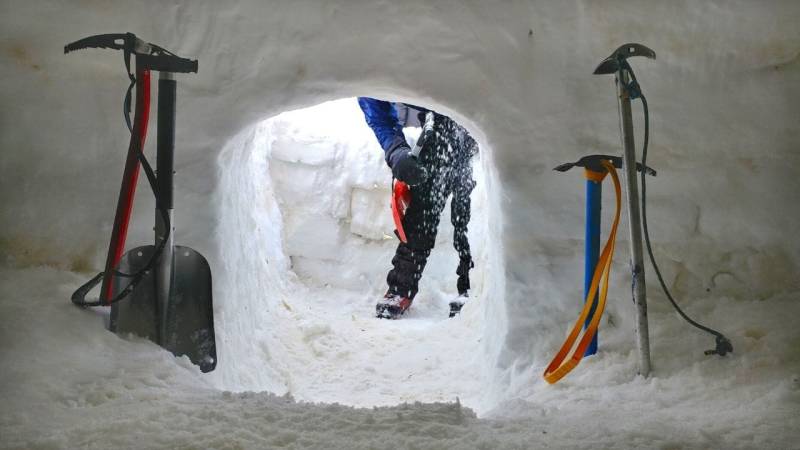
If it snows particularly heavily, you need to get up regularly at night and shovel out the entrance. But keep in mind point 1 (sweating) and point 2 (hypothermia).
You have to weigh up for yourself what is more important: a good night's sleep or being able to escape your snow cave quickly and easily.
7. Injuries
Serious injuries are often deadly in the wilderness.
Therefore, a basic principle of survival is: Never take risks.
So make sure you avoid injuries while digging your snow cave. Even minor sprains can significantly limit your daily routine.
Building a snow cave poses several risks of injury and you should be careful.
Injuries during construction: For example, if you accidentally injure your partner while digging the snow cave together. It's probably tight inside the snow cave as well. Take turns if there are two of you, so one can take a break and nobody sweats too much.
Injuries from slipping: If you keep walking on the same spots, the snow becomes compacted and slippery. Furthermore, the snow melts and freezes again around your fire pit, creating ice. Ice can also form inside the snow cave if you use it for many days. Plan enough time each day to keep your snow cave safe.
Have you ever spent the night in a snow cave? Or in an igloo? Please let us know in the comments.


Author of the guide
Martin Gebhardt
Hey, I'm Martin. On my blog, you will learn the basics and numerous details about living in the wild. I think survival, bushcraft and the good life in nature are the keys to happiness. Find me here on Instagram or on YouTube. You can find more about my mission on the About Me page.
Was this guide helpful?
14 people found this guide helpful.
5.00 out of 5 points (14 Ratings)
Comments (0)
This post may contain affiliate links. So if you click on the links and make a purchase, I will receive a small commission at no additional cost to you. Click here, to learn more about it.


